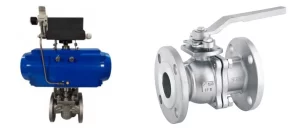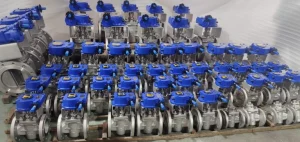Plug Valve vs. Ball Valve: Key Differences Explained
Understanding Plug Valves
Design and Functionality of Plug Valves
Plug valves belong to a category of valves known as quarter-turn valves. These valves utilize a conical plug to regulate the flow of fluids within a system. The plug includes an aperture that lines up with the flow path in the open position and obstructs it when shut. This straightforward design enables dependable operational performance.
Types of Plug Valves
There are various plug valves available, such as lubricated ones that use lubricants to decrease friction between the plug and the body, non-lubricated ones that rely on a sleeve or liner for the same purpose, eccentric plug valves with an offset plug to minimize wear, and expanding plug valves that create a secure seal by expanding against the valve seat.
Advantages of Using Plug Valves
The main benefits of plug valves are their simplicity and reliability in ensuring a seal when closed off tightly and efficiently operating with minimal flow resistance for high flow scenarios while being easy to use and maintain due to their uncomplicated design.
Common Applications for Plug Valves
Industries Utilizing Plug Valves
Plug valves find application across various industries like oil and gas extraction operations as well as chemical processing plants and power generation facilities due to their sturdy construction that enables them to effectively manage harsh or corrosive fluids.
Specific Use Cases for Plug Valves
Plug valves are commonly used for shutting off or opening up the flow in pipelines to control movement swiftly and efficiently; they can be particularly useful in handling fluids without the risk of blockages in slurry applications.
Exploring Ball Valves
Structure and Mechanism of Ball Valves
Ball valves have a disc with an opening in the middle that regulates the flow of fluids within them. When the hole in the ball aligns, with the direction of flow the valve is open. Spinning the ball by 90 degrees shuts off the valve. This setup guarantees operation and minimal torque needs.
Types of Ball Valves
There are two types of ball valves: floating ball valves and trunnions-mounted ball valves. Miwival floating ball valves are designed for sealing and require minimal torque to operate, while trunnions-mounted ball valves have extra support at both ends of the ball to decrease operating torque even more.
Benefits of Using Ball Valves
Ball valves provide advantages such as effective sealing abilities and user-friendly operation features. Miwival ball valves incorporate a packing gland that allows for convenient adjustments, without the need to remove any mounting equipment or the operator themselves—ensuring a hassle-free maintenance experience and extended operational lifespan.
Common Applications for Ball Valves
Industries Utilizing Ball Valves
Fields like oil and gas production and distribution or pharmaceutical manufacturing and water treatment facilities, commonly rely on ball valves for their adaptability and lasting performance.
Specific Use Cases for Ball Valves
Ball valves are often utilized in situations that demand sealing properties for safety purposes. Miwival 3-piece ball valves are designed to be fire-safe according to API 607 standards, making them perfect for applications prioritizing safety measures.
Comparing Plug Valves and Ball Valves
Operational Differences Between Plug and Ball Valves
Both plug and ball valves operate with a quarter-turn motion, in practice, but have distinct internal mechanisms. Plug valves use a cylindrical plug that rotates within the body to regulate flow, while ball valves feature a spherical disc with a central bore.
Performance Characteristics
In terms of performance effectiveness, both options provide sealing capabilities although ball valves typically offer improved flow characteristics because of their larger bore size compared to their body size. All resilient seat materials ensure a seal in both directions, in Miwival ball valves.
Selecting the Right Valve for Your Needs
When deciding between plug valves and ball valves for your applications, needs and performance requirements must be carefully evaluated to ensure optimal functionality is achieved based on factors like the type of fluid being managed and the specific pressure and temperature conditions, alongside flow capacity and maintenance demands.
- Fluid Type and Characteristics.The type and properties of the fluid play a role in determining the appropriate valve to use. Whether it’s abrasive or corrosive or contains particles can affect the choice of valve selected for the application at hand. Plug valves are known for their durability in handling corrosive fluids because of their uncomplicated design and ability to create a secure seal. In contrast to plug valves’ robustness, ball valves excel in providing seals with their resilient seat materials.
- Pressure and Temperature Conditions.Both plug and ball valves are capable of operating under pressure and temperature conditions. For example, Miwival provides ball valves that are either “nonfire safe with standard stem seals or fire safe to API 607, with graphite stem seals,” specifically designed for high-temperature environments.
- Flow Capacity Need.Ball valves generally provide improved flow performance because of their inner diameter compared to their outer dimensions, making them ideal for situations that demand higher flow rates. In contrast, plug valves could be favored in scenarios where exact flow regulation is not as crucial.
- Maintenance Requirements.When choosing a valve type to use in your system or machinery setup, it’s important to consider maintenance requirements. Miwival ball valves come with features like the “independent packing gland,” which can be adjusted without the need to remove any mounting hardware or operator components.
Introduction to Miwival Products
Overview of Miwival Valve Offerings
At Miwival you can find a selection of valve solutions tailored to various industrial requirements, offering a range of ball valves that are crafted to deliver top-notch performance and dependability for a variety of uses.
Among the products from Miwival are floating ball valves, which are renowned for their ability to provide a seal and require minimal operating force; trunnion-mounted ball valves that offer even lower operating torque due to the added support at both ends of the ball; and three-piece ball valves that adhere to fire-safe design specifications according to API 607 standards.
Miwival Valve Industry Solutions
Miwival caters to various industries by providing tailored valve solutions that address specific challenges faced by each sector:
- Miwivalrobust valves are well-suited for the oil and gas sector in situations involving abrasive fluids. Bolstering performance, in harsh environments is a key feature of their products ensuring safety standards are met with specialized fire-safe designs.
- In chemical processing scenarios where preventing corrosion is crucially important to ensure durability against corrosive substances, Miwivalprovides stainless steel alternatives as well as custom coatings like PTFE/PFA coating (40 – 70 um), on multi-port ball valves to boost resistance.
- Management; When it comes to water treatment facilities that need fluid control systems to handle large volumes under different pressures and temperatures, Miwivaldiverse range ensures compatibility across various stages of these processes. This is largely attributed to innovations such as self-adjusting stem seals that automatically adapt packing to account for temperature changes and other factors.
- Power generation plants greatly profit from Miwivaltop-notch solutions tailored for safety settings, ensuring uninterrupted operations to avoid costly downtime due to unexpected maintenance disruptions.
With a range of product options supported by creative engineering methods that prioritize delivering top-notch quality and reliability, customers worldwide rely on us when it truly counts.







